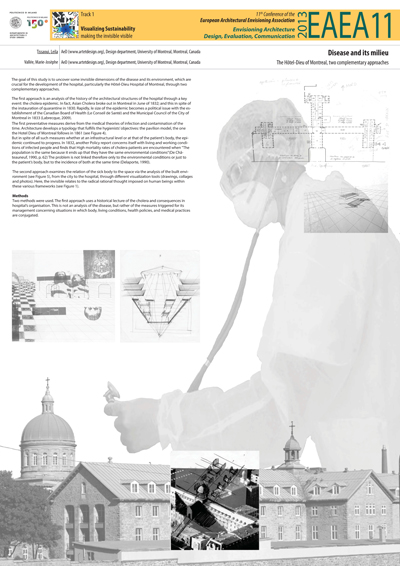11th EAEA Envisioning Architecture: Design, Evaluation, Communication Conference in 2013
Track 1 | Visualizing Sustainability - Making the invisible visible
Disease and its milieu: the Hôtel-Dieu of Montreal, two complementary approaches
Keywords: disease; control device; hospital
ABSTRACT
The goal of this study is to uncover some invisible dimensions of the disease and its environment, which are crucial for the development of the hospital, particularly the Hôtel-Dieu Hospital of Montreal, through two complementary approaches.
The first approach analyses the history of the architectural structures of the hospital through a key event which is the cholera. It is not an analysis of the disease but of the devices triggered by its management that concern a situation in which body, living conditions, health policies and medical practices are put together. The « invisible » relates in this case, on the one hand, to these mechanisms induced by cholera (see « the germ theory »), and on the other hand to the effects on the relation of the body to its milieu (habits, personal hygiene, waste management).
The second approach examines the relation of the sick body to the space via the analysis of the built environment, from the city to the hospital, through different visualization tools (drawings, collages and photos). Here, the invisible relates to the radical rational thought imposed on human beings within these various frameworks. This approach applies a direct observation methodology of field surveys and drawings of the urban fabric, streets, housing, of the Hôtel-Dieu Hospital and its entrance, corridors, rooms, and of bodies placed in specific locations for specified purposes. The iconographic analysis reveals a deep consistency between space, power and body, where the materialization of the invisible concretely occurs through the organization of life.
The results show the importance of the invisible dimensions which profoundly affect the visible: the organizational structure and principles of the hospital milieu. On the one hand the iconographic analysis makes the space visible, considered as a control device through the assembly of figures from the Hôtel-Dieu Hospital, part of the urban Montreal, juxtaposed to the inner world of the hospital (eg Curtain wards, beds, patients). On the other hand, the analysis of the devices put in place for cholera allow to see the impact on the spatial organization (eg water supply, birth of surgical and laboratory) but also taking into account a crucial principle , the interdependence between the body and its environment. This relational principle redefines the notion of isolation, since it is no longer about isolating the body by moving it or inflicting on it a material separation. It must be isolated from its own environment, involving the consideration of several "layers" to avoid contamination of the milieu: that of the skin (the body), that of the material physical environment and that of the atmosphere. We can also see nowadays the importance of medicalization and public health measures during the early phase of epidemics such as the H1N1 outbreak. These actions apply to all public spaces, (specifically border areas), and relate to the body (multiplication rules of personal hygiene: wearing mask, hand washing, medical exam, etc.) and his milieu (security area with medical facilities for affected travelers, etc.).
AUTHORS
Leila Tissaoui
Groupe de recherche AeD, Faculté de l’Aménagement, Université de Montréal, Montréal, Québec, Canada
Marie-Josèphe Vallée
Groupe de recherche AeD, Faculté de l’aménagement, Université de Montréal, Montréal, Québec, Canada
